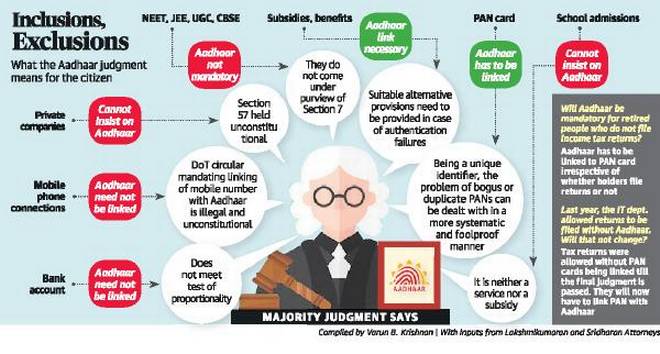Why in news?
- The Supreme Court recently upheld the constitutionality of the Aadhaar in its majority verdict (4 out of 5 judges).
- Click here to know on the grounds for petitions filed against Aadhaar.
What are the highlights of the majority verdict?
- The majority ruling called Aadhar “a document of empowerment”.
- The ruling has highlighted two main aspects of the unique identification project -
- Aadhaar as digital identity infrastructure
- Aadhaar's application as public infrastructure for various purposes

- Right to privacy - Not all matters pertaining to an individual were an inherent part of the right to privacy.
- Only those matters in which there was a reasonable expectation of privacy were protected by Article 21 of the Constitution.
- In this context, the Aadhaar scheme passed the triple test laid down in the Puttaswamy (Privacy) judgment to check if it invades privacy viz.
- existence of a law - backed by the statute i.e. the Aadhaar Act
- a legitimate state interest - to ensure that social benefit schemes reach the deserving community
- test of proportionality - balances the professed benefits of Aadhaar and the potential threat it carries to the fundamental right to privacy
- Money Bill - Section 7 of the Aadhaar Act mandates that individuals should produce Aadhaar to access social services, subsidy, benefits, etc.
- Moreover, it is clearly declared that expenditure incurred in this respect would be from the Consolidated Fund of India.
- Since Section 7 is the main provision of the Act, the validity of the Aadhaar Act being passed as a Money Bill is upheld.
- Surveillance state - During the enrolment process, “minimal biometric data in the form of iris and fingerprints is collected”.
- Also, UIDAI “does not collect purpose, location or details of the transaction”.
- Hence the manner of operation of Aadhaar, "do not tend to create a surveillance state".
- Security of biometric data - UIDAI has mandated only registered devices to conduct biometric-based authentication transactions.
- With these registered devices, the biometric data is encrypted within the device using a key.
- This creates a unidirectional relationship between the host application and the UIDAI.
- This also rules out any possibility of the use of stored biometric, or the replay of biometrics captured from another source.
- Further, as per the regulations, authentication agencies are not allowed to store the biometrics captured for Aadhaar authentication.
- Telecoms - Aadhaar-based re-verification of mobile numbers has been held illegal and unconstitutional as it was not backed by any law.
- As a result-
- telecom cannot insist on customers to furnish Aadhaar details
- the provision that allowed private entities to conduct authentications has been held illegal.
- corporate bodies including banks, mobile wallets, etc also cannot ask for customers' Aadhaar number.

- PAN - Section 139AA of IT Act makes Aadhaar mandatory for filing IT returns and applying for PAN.
- Since it stood the triple test and did not violate the right to privacy, linking of PAN with Aadhaar will be mandatory.
- But there was no deadline mentioned by the court.
- It is also said that if in the regulations, a provision was made that impinged upon the right to privacy, it could be challenged.
- Linking of bank accounts - Linking of bank accounts and other financial instruments with Aadhaar were made mandatory by 2017 amendment to Prevention of Money Laundering Act Rules, 2005.
- It does not stand the proportionality test because just for preventing money laundering, there cannot be such a provision targeting every resident as a suspicious person, which is seen as disproportionate.
- Therefore it violates the right to privacy of a person which extends to banking details and hence the amendment is declared unconstitutional.
- Details already given - The judgment does not clearly state if banks/mobile companies that have already collected Aadhar data will have to delete the collected information.
- But the court has upheld the validity of Section 59, which validates all Aadhaar enrolment done prior to the enactment of the Aadhaar Act, 2016.
- The court has said that since enrolment was voluntary, those who refuse to give consent would be allowed to exit.
- Aadhaar for education - Statutory bodies like CBSE and UGC cannot ask students to produce their Aadhaar cards for examinations like NEET and JEE.
- Aadhaar would also not be compulsory for school admissions as “it is neither a service nor subsidy” but a fundamental right for children between 6 and 14.
- Aadhaar for children - The consent of parents/guardians will be essential for the enrolment of children under the Aadhaar Act.
- On attaining the age of majority, such children shall have the option to exit.
- Section 33(1), Aadhaar Act - It prohibits disclosure of information (identity and authentication), except when it is by an order of a district judge or higher court.
- The judgment enabled individuals to have a right to challenge such an order passed by approaching the higher court.
- Section 33(2), Aadhaar Act - It provides for disclosure of information in the interest of national security when directed by an officer of Joint Secretary or higher rank.
- The court struck down this provision in the present form.
- It held that an officer higher than this rank should be given such a power and a Judicial Officer (preferably an HC judge) should also be associated with it.
- Section 47, Aadhaar Act - It provides for cognisance of offence only on complaint by UIDAI (or any person authorised by it).
- The court ruled that this needed suitable amendment to provide for filing of complaints also by an individual whose right was violated.
- Section 57, Aadhaar Act - It provides for use of Aadhaar number for establishing the identity of an individual for any purpose, by the state or any corporate or person.
- The court has said that the section would impinge upon the right to privacy of the individual and enable commercial exploitation of biometric and demographic information.
- The court thus read down (providing narrow interpretation) this provision as susceptible to misuse.
- Regulation 26(c), Aadhaar Regulations - It allowed UIDAI to store metadata relating to transactions.
- The court struck down this regulation in its present form.
- Regulation 27 - It allowed archiving transaction data for 5 years.
- The court struck down this and allowed only upto 6 months.
What are the highlights of the minority judgment?
- Justice D Y Chandrachud gave the dissenting minority judgment in which he observed the following.
- Surveillance - The architecture of Aadhaar poses a risk of potential surveillance activities through the Aadhaar database.
- From the verification log, it is possible to locate the places of transactions carried out by an individual over the past five years (now made six months).
- It was also possible to track an individual’s location through the Aadhaar database, even without the verification log.
- Money Bill - Passing of a Bill as a Money Bill, when it does not qualify for it, damages the delicate balance of bicameralism.
- Notably, bicameralism is part of the basic structure of the Constitution.
- The ruling party in power may not command a majority in the Rajya Sabha.
- But the legislative role of that legislative body cannot be obviated and passing it as money bill was “a fraud on the Constitution,”
- Shortfalls - Denial of benefits arising out of any social security rights is violative of human dignity and impermissible under the constitutional scheme.
- The biometric authentication failures under Aadhaar that have led to denial of rights and legal entitlements were highlighted in this regard.
Click here for Part II
Source: The Indian Express, The Hindu

